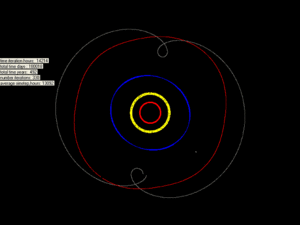(470308) 2007 JH43
| Discovery [1] | |
|---|---|
| Discovered by | Palomar Obs. Unaccredited: M. E. Schwamb M. E. Brown D. L. Rabinowitz |
| Discovery site | Palomar Obs. |
| Discovery date | 10 May 2007 |
| Designations | |
| 2007 JH43 | |
| TNO[1][2] · Plutino[3] SDO (DES)[4] | |
| Orbital characteristics [1] | |
| Epoch 31 July 2016 (JD 2457600.5) | |
| Uncertainty parameter 3 | |
| Observation arc | 31.34 yr (11,446 days) |
| Aphelion | 40.566 AU |
| Perihelion | 38.612 AU |
| 39.589 AU | |
| Eccentricity | 0.0247 |
| 249.10 yr (90,983 days) | |
| 177.14° | |
| 0° 0m 14.4s / day | |
| Inclination | 18.129° |
| 64.584° | |
| 4.7053° | |
| Physical characteristics | |
| Dimensions | 505 km (assumed)[5] 529.08 km (calculated)[6] |
| 0.09 (assumed)[5] 0.10 (assumed)[6] | |
| C [6] | |
| 4.49±0.05 (S)[7] 4.5[1][6] | |
(470308) 2007 JH43, provisional designation 2007 JH43, is a trans-Neptunian object in the outer regions of the Solar System, approximately 500 kilometers in diameter. It was discovered on 10 May 2007, by the U.S. Palomar Observatory in California. The team of unaccredited astronomers at Palomar consisted of Megan E. Schwamb, Michael E. Brown and David L. Rabinowitz[2]
The minor planet orbits the Sun at a distance of 38.6–40.6 AU once every 249 years and 1 month (90,983 days). Its orbit has an eccentricity of 0.02 and an inclination of 18° with respect to the ecliptic.[1] The first precovery was taken at the Australian Siding Spring Observatory during the Digitized Sky Survey in 1984, extending the body's observation arc by 23 years prior to its discovery observation.[2] It came to perihelion around 1888.[1] Based on an absolute magnitude of 4.5 and assuming a generic albedo for trans-Neptunian objects of 0.09, it is about 500 kilometres (310 mi) in diameter, which makes it likely a dwarf planet.[8][5]
Orbital classification
As of 2014, the Minor Planet Center listed 2007 JH43 as a plutino (a trans-Neptunian object in 2:3 mean-motion resonance with Neptune).[2][3] However, the Deep Ecliptic Survey currently shows it as a scattered object, based on a 10-million-year integration of the orbit.[4]

References
- ^ a b c d e f "JPL Small-Body Database Browser: 470308 (2007 JH43)" (2015-07-09 last obs.). Jet Propulsion Laboratory. Retrieved 16 November 2016.
- ^ a b c d "470308 (2007 JH43)". Minor Planet Center. Retrieved 16 November 2016.
- ^ a b "MPEC 2010-S44 : DISTANT MINOR PLANETS (2010 OCT. 11.0 TT)". IAU Minor Planet Center. 2010-09-25. Retrieved 2014-04-06.
- ^ a b Marc W. Buie. "Orbit Fit and Astrometric record for 07JH43" (last observation: 2012/05/16 using 45 of 45 observations over 28.19 years). SwRI (Space Science Department). Archived from the original on 2016-06-16. Retrieved 2014-10-13.
{{cite web}}: Unknown parameter|dead-url=ignored (|url-status=suggested) (help) - ^ a b c Wm. Robert Johnston (24 March 2015). "List of Known Trans-Neptunian Objects". Johnston's Archive. Retrieved 2015-07-22.
- ^ a b c d "LCDB Data for (470308)". Asteroid Lightcurve Database (LCDB). Retrieved 16 November 2016.
- ^ Benecchi, Susan D.; Sheppard, Scott S. (May 2013). "Light Curves of 32 Large Transneptunian Objects". The Astronomical Journal. 145 (5): 19. Bibcode:2013AJ....145..124B. doi:10.1088/0004-6256/145/5/124. Retrieved 16 November 2016.
- ^ "How many dwarf planets are there in the outer solar system?". Gps.caltech.edu. 2015-07-21. Retrieved 2015-07-22.
External links
- Orbital simulation from JPL (Java) / Horizons Ephemeris
- 2007 JH43 Precovery Images
- (470308) 2007 JH43 at the JPL Small-Body Database


